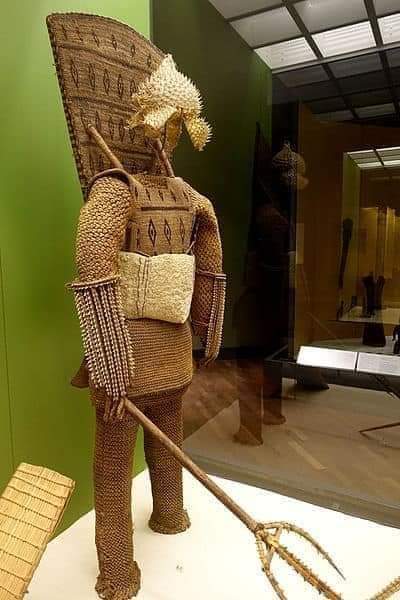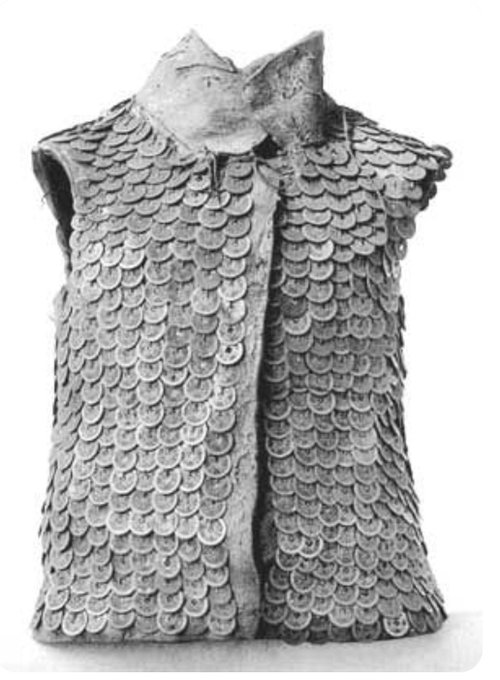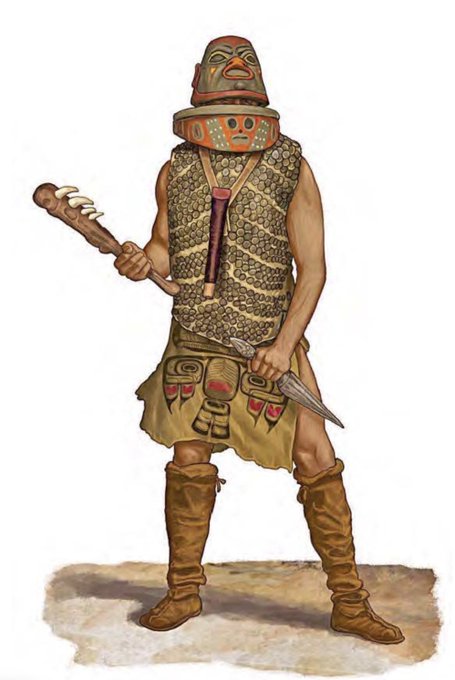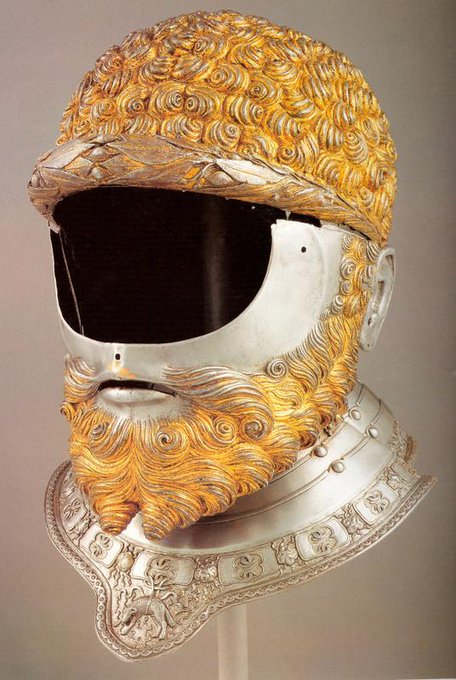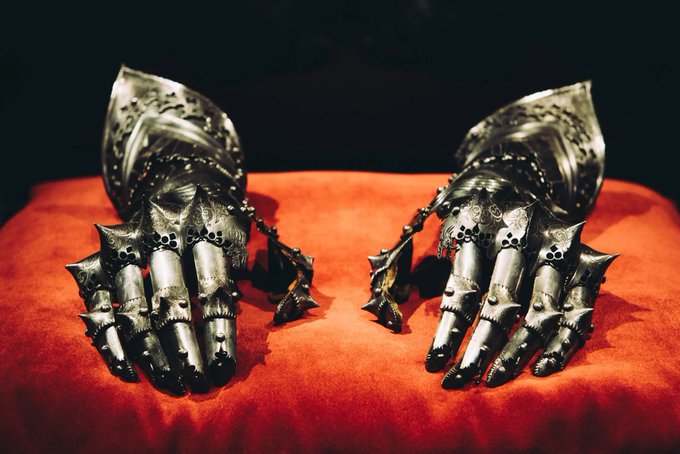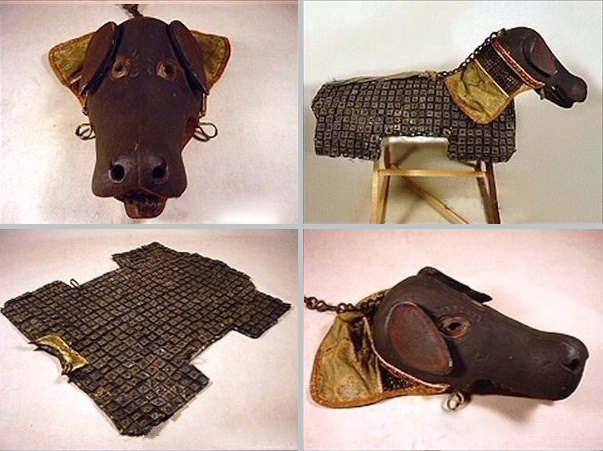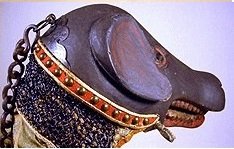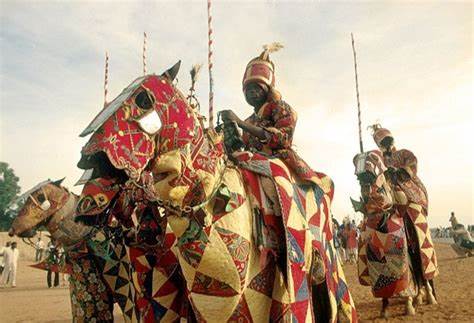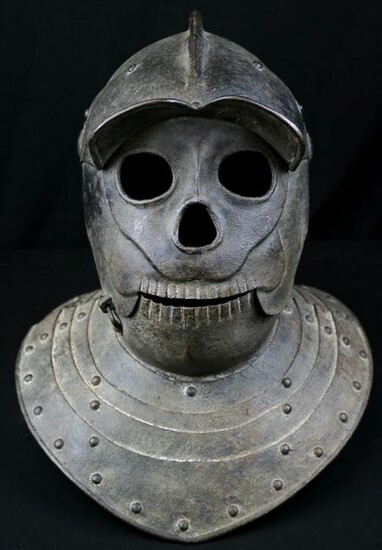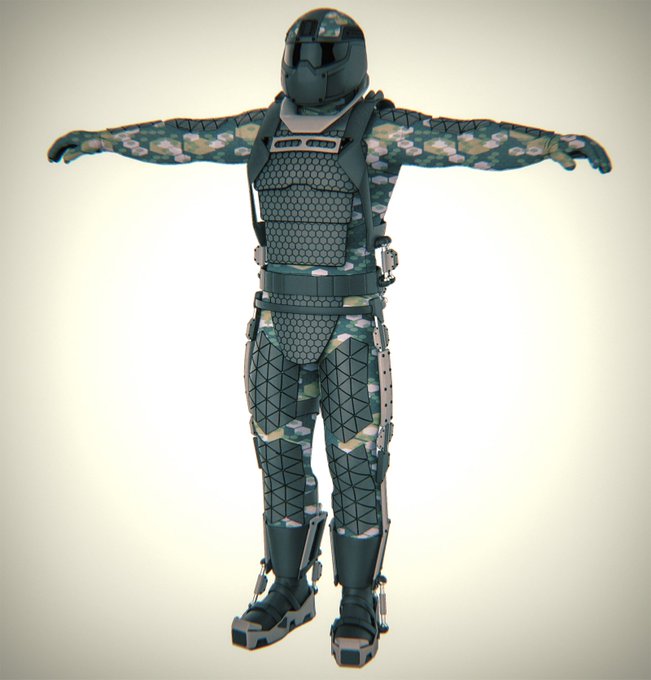Most Incredible Armor of All Time

October 30, 2024
•17 min read
Let's investigate a suit made of spikes, weaponized beekeepers and some of the most incredible armors of all time.
Throughout the centuries, nations have battled one another, forcing soldiers to defend themselves in increasingly ingenious ways. Through this, functional fighting armor was developed, but over millennia different cultures have adjusted their armors to fit a variety of purposes, resulting in some of the most mind-blowing suits you’ve ever heard of. From fearsome bear fighting barbs, to fully powered exoskeletons, let’s take a look at some of the most incredible armor of all time!
Kolben Tournament Helmets
While it might look like a hellish beekeeper headpiece, these bulbous grated helmets are actually called Kolben helms and they were found in Germany in the mid-14th to 15th century. They were worn by mounted tournament combatants armed with clubs, blunted swords, or Kolbens, hence the name.
These frightening face cages varied in size, but some of the larger surviving relics measure about 19 inches tall and 10 inches wide and weigh upwards of 13 pounds, so it would have been like wearing a large, hollow bowling ball on your head! This type of tournament armour often locked the wearer in place, so with all that weight pressing down, it probably wasn’t the comfiest thing to wear. Crafted from an iron structure, with some variants covered by canvas and gesso adorned with a floral pattern, these helmets were padded inside to fend off most injuries. As incredible as they look, due to the delicate gesso decoration, very few of them have survived intact to the present day.Te Barantauti Puffer Fish Helmets
The Kiribati people first arrived on the island of Kiribati in Micronesia roughly 5,000 years ago. With materials scarce, these resourceful people crafted te barantauti, armor made from the dried remains of fish! The helmet was crafted by catching an inflated puffer fish, burying it, and, in a week, it’d dried out to the point where all that remained was a hard, spikey skin.
They weaved breastplates and back plates from coconut fiber, and completed the ensemble with swords made of wood inlaid with shark teeth! As impressive as te barantauti looks, this armor was not great for combat. The warrior wearing it would need to be propped up during duels, and the armor itself would shatter under a single solid blow. Instead, it was likely used for ritualized combat and ceremonies.Kiribati Armour (1883 CE), from Pacific, Kiribati Islands. Helmet is made from 'Porcupine Fish' and forearms are protected by 'Shark Teeth'. For millennia, a Kiribati family’s wealth was measured by both that land and their ability to wring clothing, food, and shelter from it.
Brewster Body Shield
In 1917, World War I was raging, and American doctor Guy Brewster wanted to do his part. So, he did what any normal man would do at that time, he invented his own suit of armor. It consisted of a large shield-shaped body plate that was 0.2 inches thick, secured with shoulder buckles, and rounded off with a bucket-like helmet to protect the wearer’s head from all angles.
In April of that year, Brewster donned the armor himself to demonstrate its merits. He was struck with a sledgehammer, and then shot at with a machine gun! Lucky for him, the tests were successful, with Brewster claiming that the impact of the gun fire was only a tenth of the shock of a sledgehammer. Even so, weighing a hefty 40 lbs, the armor was cumbersome to wear, and the helmet reduced visibility significantly, meaning it was practically useless. Also, by 1917 the war was drawing to a close and so the armor never took off.Tlingit Armor
This armor was traditionally worn by the Tlingit tribe, who’ve inhabited southeastern Alaska and nearby islands since around 8,000 BC. These warriors wore a sleeveless hide coat custom fit to the body with a wooden collar and helmet, which depicted the faces of humans or animals, and were designed to instill terror in their enemies.
Tlingit armour plated with Chinese coins that date from 1662-1736. From modern day Sitka, southern Alaska. It is thought the Tlingit received Chinese coins in trade from Boston sea merchants in exchange for sea otter pelts, according to the American Museum for Natural History.

Filippo Negroli
If you want to stand out today, you wear clothes from famous designers like Giorgio Armani or Calvin Klein. But back in the 16th century, the one name on everyone’s lips was Filippo Negroli. His armor designs were completely impractical for the battlefield, but were so detailed that the wealthy purchased armor from him purely to show off just how rich they were during parades and ceremonies!
Greco-roman inspired Parade helmet (with missing visor) of Emperor Charles V (1500-1558) by Filippo Negroli. The hair and beard are made from gold. Spanish, 1533 AD. Royal Armory at the National Gallery of Art, Madrid.
The Gauntlets Of Maximilian I
From the late 15th to the early 16th century, Holy Roman Emperor Maximilian I reigned supreme. This emperor loved armor, as you can tell by the absolutely incredible steel-forged gauntlets in the image below. The late gothic style means they were probably created around the 1490s, or possibly the 1520s with that intricate floral etching.
The Gauntlets of the Holy Roman Emperor Maximilian I, circa 1490. @AulicCouncil
Dog Armor
So at this point, we know humans needed armor, but it turns out our animals did too! Man’s best friend, the dog, has been enlisted in wars for at least 3,000 years by various ancient civilizations. And if we rewind to Japan’s late Edo period, around the 18th century, one eccentric samurai had a full set of armor commissioned for his pooch, including a mask made of carved wood!
Доспехи для собаки, Япония, XIX век. Видимо они были созданы для собаки высокопоставленного самурая или феодала в средний или поздний период Эдо. #Доспехи #собаки #Япония #самурая #феодала #Эдо #музей #Forge #Кузница #bsmith_ru
Elephant Armor
They say bigger is better, and that’s probably why people used war elephants! Elephantry were used in battle to break enemy ranks and instill fear, but even these living tanks needed some protection. Check out this armor in the image below made for an adult Asian elephant, hailing from around 17th or 18th century India.

Siberian Bear-Hunting Suit
Adding spikes onto anything makes it 1000 times more sinister, even more so when the thing covered in spikes is weirdly sinister to begin with, like the armor in the image below. That’s a two-piece leather hunting suit, complete with mask, covered from head to toe in wooden spikes.

Parade Armor Of Sigismund II Augusts
In the 1550s, Sigismund II Augustus, the Grand Duke of Lithuania and King of Poland, pranced around in an impressive suit, which was designed to coordinate perfectly with his horse! He was gifted the set, made by renown German armorer Kunz Lochner, by his sister, who hoped that just by putting on the armor his enemies wouldn’t attack because the armor itself was too wonderful. His sister probably didn't understand how war worked!
Even so, the wearable art boasted steel, brass, leather, and silk, intricately decorated, with a visor-type helmet through which he could see. His horse’s armor matches it in every way down to the gilded saddle, and the shaffron, which is the face guard, even sports great golden gilded ram horns!Jibbah
We’ve all heard about the stereotypical European knights who pranced around clad in plate and chain mail, battering each other with swords, but what about the warriors in much hotter climates? It's reasonable to think that they couldn’t wear all that metal, as they’d overheat. However, in parts of sub-Saharan Africa, particularly the Sahel region, warriors sported thick, quilted armor called jibbahs.
History Of The Kanem-Bornu Empire That Existed From The 9th To The 19th. (Ahmed Tinubu Apostle Makinde RCCG Adeola Naira Marley Nigeria Labour Congress Ned King of Boys)
Todenkopf Death Head Helmets
While we tend to believe that knights were brave and gallant, the Savoyard helmet might make you think otherwise! Today, the Savoyards refers to the elite cavalry units formed by Charles Emmanuel I, Duke of Savoy.
Originally attributed to the knights of Germanic countries, some variations of these "death head helmets" were used by Italian troops in the 16th and early 17th centuries and are referred to as Savoyard helmets.
Somen Samurai Masks
There’s nothing cooler than samurai masks, often called men-gu or men-yoroi! Somen is the Japanese term for masks that completely covered the face. These were often worn by high-ranking samurai, typically made from lacquered metal or leather, giving them a range of colors. These masks varied greatly in style, though my personal favorite has got to be those made in the Ressei style.
Kabuto Samurai Helmet
The style of 16th Century helmet in the image bellow is called a kabuto, where the bowl is made of 28 steel plates, while the neck guard is made of five steel plates covered with lacquered leather and joined with silk threads. The gilded octopus, which is made of iron overlaid with papier mâché, could be removed, depending on the occasion the samurai was attending. That is to say, he wouldn’t be charging into battle with an octopus on his head!
The owner of this swanky thing would’ve been a high ranking samurai, with the kabuto a symbol of just how high status he was. It’s no surprise why this dude would’ve wanted a cephalopod on his head, because the octopus is a significant cultural symbol in Japan, representing the relationship between the people, the sea, and its inhabitants.Polish Hussars
The troop of Polish hussars is a heavy cavalry served the Polish-Lithuanian Commonwealth between 1503 and 1702. The first thing you’ve probably noticed about these awesome avengers in the image below are those large wings attached to the cuirass.
Made of wooden slats with eagle, falcon or vulture feathers, they would have been a vision to behold. The Hussars acted as shock troops; as they charged forward the sight and sound of their clattering wings is believed to have spooked the enemy’s horses, and the enemy too! The rest of the hussar’s armor was made to measure for easy movement, keeping it light and comfy, weighing around 33 lbs. This allowed the hussars to be relatively quick and let their horses gallop at full speed for extended periods.Eliseus Libaerts
We all like to express ourselves; some through drawing, some through painting, some through the crafting of armor, and back in the 1550s, Eliseus Libaerts was the armor maestro. He cobbled this set together for Maximilian II of the Holy Roman Empire.
Welded from steel and brass, this was richly decorated with scenes of Roman mythology, with mini-Heracles dotted everywhere. That’s not the only legendary armor Libaerts constructed. Between 1563 to 64, Libaerts was at it again, he created this stunning parade armor for King Erik XIV of Sweden.Gestech: Joust Of Peace
In the early 16th century, Germans loved their jousting so much that they created the Gestech, which means joust of peace. This has two contestants armed with blunt lances who charge at each other. The aim is to unseat the opponent or break a lance against their armor. Doesn’t sound peaceful.
The cool part about this armor though was that the horse wore a straw-filled chest bolster as a bumper to protect both itself and the rider's legs in case of a collision. The horse would also wear a blind shaffron on its head to keep its eyes covered and prevent it from shying away from the charge. By the 1580s and 90s, jousting in Europe was old news. However, in the now German state of Saxony, it was still in full force, and incredible suits, like this set in the image below, were being made to one up the competition. The whole thing together weighed over 90lbs, that’s about half the weight of the average modern man. A lot of that weight came from the thick shoulder shield strapped onto the armor, designed to keep the wearer’s torso in one piece after being slammed with a lance! It’s believed that this armor was worn at a wedding tournament in Dresden.Dingjia: Armor With Nails
The high-ranking officials at the Chinese imperial court of the 18th century used to wear this armor below! This ceremonial armor is called dingjia, which means armor with nails. It consists of a jacket with sleeves and an ankle-length skirt, and its name comes from the fact that it is crafted from overlapping plates nailed inside the fabric layers, flaunting those all-important nail heads that can be seen on the costume’s exterior. Being a fairly impractical military costume, officials wouldn’t let this get scuffed up in a real battle.
The Armored Skeleton Of Saint Pancratius
In 1672, a strange package arrived at the Swiss city of Wil. Though it wasn’t just any package, it was St Pancratius, a martyred saint. And it wasn't a statue of him, it was what was left of him. He originally arrived dressed in a roman legionary uniform, but after being stored in the city’s catholic church for several decades, the remains were eventually placed in a suit made by a silversmith in Augsburg, Germany, in the 18th century.
The parade armor he was gilded in featured a golden halo over the helmet, and a silvered tunic type gown covering the lower half. Obviously, this wasn’t practical armor, but it provided a solidly posed structure to showcase the martyr’s remains. But why?TALOS
While historic sets of armor are cool, the futuristic sets you find in video games are on another level, like the combat suits from EVE Online, and something similar was almost become a reality. Back in 2013, the U.S. Special Operations Command announced the development of a Tactical Assault Light Operator Suit or TALOS.
The Ratnik Pack
It’s not just the US looking to the future, because Russia’s Ratnik 3 seems to echo some of the earlier promises of the TALOS suit. It too is a powered exoskeleton, with a lower half comprised of a titanium framework fixed to a small powerpack on the back that enables increased strength and stamina.
Russian "Ratnik-3" Armor Suit/Exoskeleton reference model made for the LAZARUS comic book (Greg Rucka and Michael Lark). Modeled in #Sketchup , rendered in #Keyshot


